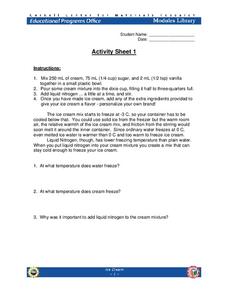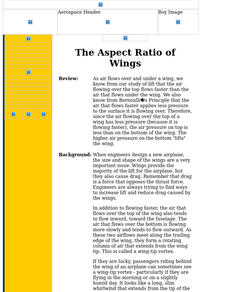Curated OER
What Made George Washington a Good Military Leader? Powers and Problems
High schoolers list qualities they believe made George Washington an effective military leader. They discuss difficulties Washington faced as Commander-in-Chief and how he responded to the difficulties he faced as the leader of the...
Curated OER
Hands On: Multiply Whole Numbers and Fractions
Learners sharpen their problem solving skills as they solve six story problems.
Howard Hughes Medical Institute
The Making of the Fittest: Got Lactase? The Co-evolution of Genes and Culture
Got milk? Only two cultures have had it long enough to develop the tolerance of lactose as an adult. Learn how the responsible genes evolved along with the cultures that have been consuming milk. This rich film is supplied with a few...
International Reading Association
Children’s Choices 2014
Books for kids, chosen by kids! What could be better? This packet is made up of book lists, each with approximately 30 books included, organized by age group. Kids will enjoy the summer reading materials they choose from this resource!
Teacher's Corner
What Is a Foot?
An in-class and at-home assignment, young math stars find and list items from home and school that they think are one foot in length. Once the list is made, provide everyone with rulers to measure and find the actual lengths of their items.
California Department of Education
I Have “M.I.” Strengths!
There are so many ways to be smart! Can your class identify their intelligences? The third of five career and college lesson plans designed for sixth graders challenges them to assess their unique skills. Once they determine their...
Teach Engineering
Gumdrop Atoms
There's nothing sticky about the resource, unless you count the gumdrops! Scholars create a model of a lithium atom, complete with protons, neutrons, and electrons. It's just that these models are made with gumdrops and toothpicks.
Phys Ed Review
Physical Education Lesson Plan
Get active by dribbling a ball. Begin with a game of banana bunch and high five beanbag grab. Then, practice dribbling a ball, and identifying the part of the hand with which your active learners dribble. Finally, conclude with a game of...
Annenberg Foundation
Analyzing Artifacts
If only a mask could talk! Using the interactive tool along with historical thinking skills, pupils uncover the meaning behind the various materials the resource presents. History becomes more relevant as the artifacts tell their stories...
Illustrative Mathematics
Where Do I Go?
Practice sequencing numbers 1–100 in a card sequencing activity. The hands-on learning makes a short activity flexible and fun. The opportunities are endless and easy to implement.
Teaching Tolerance
Inventing a Better World
From play pumps that provide clean water to shoes made from trash, innovators change the world one invention at a time. After researching various inventions, young entrepreneurs develop their own. Extension opportunities include prompts...
Smithsonian Institution
Be a Food Detective
What are packaged food products really made of? This activity will prompt your learners to consider and investigate the source of ingredients in their food. They begin by breaking into groups and analyzing food labels by identifying...
Cornell University
Isotopes
What better way is there to learn about isotopes than to play with them? Chemistry students manipulate the number of protons and neutrons in a hands-on activity. Individuals try to score the largest number of points by collecting the...
American Museum of Natural History
Make Your Own Paper
Paper, paper everywhere. Paper is so prolific that few think about where the idea for it originated and how it is made. Introduce young readers to the paper-making process with an activity that lets them create their own.
Curated OER
Creating with Clay
Students are introduced to the Art Museum's Ahambra Vase. They explore the difference between throwing on the pottery wheel and hand building. Students create a functional vessel using two of the three hand-building techniques. They find...
Curated OER
Telling time to the hour
In this telling time worksheet, students draw the hands if the time is given or write the hour if the hands are given. Students complete 6 problems.
Curated OER
The Aspect Ratio of Wings
Junior engineers examine aspect ration in airplane wings. Using the length and width of two differetn wings, they calculate the aspect ratios and compare drag rankings. An engineering or space science class would benefit from this...
Curated OER
Native Pottery Replicas
Learners study ancient Native American traditions and practices. They select one type of Native American pottery to duplicate in a hand-made replica. Afterward, they create a map of the United States and label where indigenous peoples...
Curated OER
A School Yard Journal
Fourth graders create journals with explicit descriptions of objects found on the school yard. For this descriptive writing lesson, 4th graders read some of Lewis and Clark's journal entries before they explore the school yard, then...
Society for Science & the Public
Easter Islanders Made Tools, Not War
When studying artifacts, especially tools, how do archaeologists determine what the devices were used for? In what ways might researchers' previous experiences influence their perception of an artifact? An article about researchers'...
Curated OER
Hands-On: Sums of Angle Measures
In this angle measures worksheet, students solve six word problems where they are given 6 different polygons, some of which are complex, and must determine angle measures in order to arrive at a solution.
Curated OER
Multiplication and Division Word Problems Made Easy
Marbles to learn math? What fun! Discuss the rules of multiplication and division when applied to whole numbers, decimals, and fractions. Small groups use6 marbles to design different types of multiplication and division problems, and...
The Science Spot
Element Cards
This template is made up of cards for 18 common elements. The chemical symbol is provided, along with space to write in the numbers of protons, neutrons, and electrons, draw Bohr diagrams and Lewis structures, and more!
Other popular searches
- Hand Made Fractals
- Hand Made Christmas Gifts
- Hand Made Items
- Cast Hand Made Paper
- Hand Made Book Binding

























